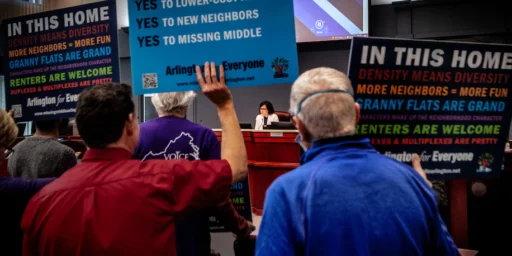Relative Deprivation and the Housing Market
Cornell economist Robert Frank argues in a new book (reviewed here by Daniel Gross) that Americans are more concerned in keeping up with the Joneses than in absolute wealth. He finds, for example, that “When asked whether they’d rather have a 4,000-square-foot house in a neighborhood of 6,000-square-foot McMansions, or a 3,000-square-foot home in a zone of 2,000-square-foot bungalows, most people opt to lord it over their neighbors.”
George Mason economist Alex Tabarrok puts this to the test, using Northern Virginia as a case study, to see whether people actually behaved this way. They decidedly do not.
Houses in neighborhoods with high average prices sell for more than similar houses in neighborhoods with lower average prices. Thus the prima facie evidence is that the same house is worth more if it is surrounded by more expensive houses – the opposite of Frank’s hypothesis.
[…]
[H]ouses with bigger lots sell for more (the positive coefficient on lotsqft) but the increase in price is less when your lot size is bigger than the average lot size. In other words, people do not want to own the biggest house in the neighborhood.
What about when your house is smaller than average? Here there is no penalty. Contra Frank, people do not mind having a small house in a neighborhood of McMansions.
That’s consistent with not only my own experience but the time-honored rule of real estate investment of “buy the smallest house in the best neighborhood you can afford.” Certainly, I’d much rather have a mediocre house in a gorgeous community than the exact same house in a slum.
As an aside, when did a 2000 square foot house get to be considered a small bungalow? Usually, bungalows are less than 1000 square feet. And, unless one has ten children, a 3000 square foot house is quite large. Or has moving to a major metropolitan area skewed my real estate perceptions?






When I was house shopping, I found lots of new neighborhoods with 3000-3500 square foot homes being offered at 165,000 to 190,000. These were on small lots and were crammed up together. They were also selling like hotcakes.
I don’t like that type of home, so I got a smaller home on a bigger lot with mature trees.
To each their own, but most people like the larger houses crammed on a small lot, so 3000 becomes the new normal.
I actually don’t see how the test invalidates the psychology behind the study, just the specific case.
It seems to me that preferring a more affluent neighborhood over a less affluent one is the same choice as preferring a larger house over a smaller one, only the comparison is at the neighborhood level, not house level. People who buy a small house is a higher-priced neighborhood are “lording over” those in the lower-priced neighborhood just as much as someone who buys the biggest house in the neighborhood.
Basically re-word the theory from buying a house, to buying in a neighborhood, and you’ll see the same result. “buy the smallest house in the best neighborhood you can afford.” is really no different from buying the best house in the neighborhood.
Maybe it’s Texas, but 3,000 sq ft is about average for a middle class home.
I think this goes more to show the problem with these type of studies than what people do in the real world.
Add to this that the nicer neighborhood probably has better services and better schools and the decision is even easier.
But it’s precisely the opposite of what Frank predicts. Theoretically, I should prefer the same house among inferior others vice among equals or betters; I don’t.
My preference for the better neighborhood has nothing to do with lording over those in lesser neighborhoods. After all, they don’t see my house. The preference is for based on aesthetics (nicer houses are better to look at), investment, having neighbors of high education, better schools, better shopping, and so forth.
“Maybe it’s Texas, but 3,000 sq ft is about average for a middle class home”
That WAS the same phenomena here in Michigan until reality set in. For $280k-$360k you too could get over your head and buy one…or a couple. Now, the market is flooded, values are dropping like a stone in most places and many banks are now taking the pleasure of trying to sell off a bunch of foreclosed houses in a flooded market.
The days of the starter castles appear to be over…here at least.
Ok, lets put it another way. Say there are 2 cities within commuting distance of your work. Both have a neighborhood where houses average 200k, both have the same quality of schools, shopping, and intellectual neighbors.
Now in city A, this neighborhood is the best there is, all others are less affluent with lesser quality schools, shopping, etc. This is where the city’s wealthy live.
In city B, this neighborhood is the least affluent , all other neighborhoods have better schools, better shopping, and more intellectual neighbors. This is where the city’s poor live.
Which of these 2 neighborhoods would be more appealing for you to buy a house in?